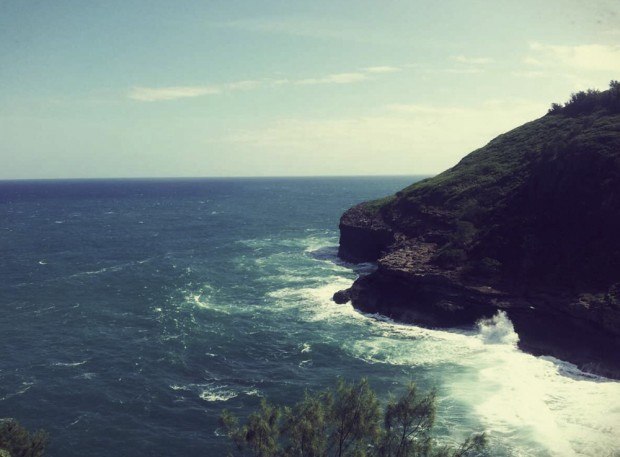LIHU‘E — While waters from open ocean surf breaks are flushing out clean in the wake of storms and flooding earlier this month on Kaua‘i, Surfrider Foundation volunteers found high bacteria counts in some streams and nearby coastal areas. The
LIHU‘E — While waters from open ocean surf breaks are flushing out clean in the wake of storms and flooding earlier this month on Kaua‘i, Surfrider Foundation volunteers found high bacteria counts in some streams and nearby coastal areas.
The Kauai‘i Chapter of the Surfrider Foundation on Monday released findings from a series of tests its volunteer Blue Water Task Force conducted Saturday around coastal areas. Samples were taken from more than 20 places, and levels of Enterococcus bacterial were compared to an average of samples taken in the last six months.
“Enterococcus is a bacterium and it is an indicator of sewage,” Kaua‘i Chapter chair Carl Berg said Tuesday.
If the bacteria count in the water reaches 104 per 100 milliliters on any given day, the state Department of Health (DOH) considers the water polluted, he said.
The DOH has a second rule to measure pollution, he said. If the average of Enterococcus concentration from five samples is 35 per 100 ml, the water is also considered polluted, according to Berg.
“Surfrider follows exactly the procedures that the DOH has, so we can compare the same numbers,” Berg said. “And the DOH has procedures that are set by the federal Environmental Protection Agency.”
The DOH samples the water from about 20 different places on Kaua‘i on a regular basis. Surfrider goes to an additional 20-plus places, Berg said. Volunteers go out into surfbreaks and streams, while DOH staff members only go to ankle-deep ocean waters, he said.
The results from the samples taken Saturday show that Kealia Beach, Wainiha Stream, Lydgate Beach Park, Hanama‘ulu Stream, Nawiliwili Stream, Koloa Landing and Pakalas were polluted.
Surfrider wasn’t able to collect samples from Waimea River, which has a six-month average of 1,035 bacteria per 100 ml.
“Kealia is not a chronically polluted place. It is only polluted when a lot of rain is falling down,” Berg said. “But places like Niumalu Beach Park or Hanama‘ulu Beach Park or Pakalas, those places are polluted all the time.”
On Monday, Surfrider took samples from Hanalei River, Waipa, Waikoko and Waioli streams, and a stream in Princeville. “Those streams are really polluted, too, as of yesterday,” Berg said.
The good news is that open ocean breaks such as PK’s and Waiohai on the South Shore and Hanalei Bay on the North Shore are clean. The bad news is that places near streams and river mouths are “definitely not clean,” he said.
Kaua‘i remains under a Brown Water Advisory issued for the entire island Feb. 27 due to heavy rains. “If coastal waters are turbid and brown, stay out,” states the DOH website.
The Surfrider Foundation’s Berg said high levels of Enterococcus may mean pollution, but the health hazards can vary from place to place.
“We are all looking at the same thing, which is Enterococcus,” Berg said. “But that’s just an indicator. We are not looking at the actual pathogens, the viruses and bacteria that makes you sick. It’s just the national approved indicator organisms.”
Berg said if the pollution is coming from human waste rather than from animals, then it’s a “real health issue.” The only way to figure out the difference is conducting expensive molecular tests, he said.
Such tests were conducted in samples from Hanalei River years ago, and human sewage was detected. As a result, Black Pot Beach Park is the only place in the state where the DOH has placed signs warning of human waste risks. Since then the EPA has been cleaning up a lot of cesspools near the Hanalei River, Berg said.
Out in Hanalei Bay, the story is different. Because of the way the bay is laid out, it gets cleaned out relatively quickly after a storm. On Saturday, the bay had a reading of 10 bacteria per 100 ml. Pinetrees, Middles and Waikoko had readings of less than 10 bacteria per 100 ml each.
Berg said Stanford University signed a contract with the government, and is about to conduct molecular tests in 16 places on Kaua‘i, including Hanalei and Nawiliwili.
“I would really think that we’ll have the results by the end of this year,” said Berg, adding that by then residents will know if the streams are polluted from human sewage or if they have just “yucky” animal waste.
Berg said his advice is to not let children play in polluted areas, to wash with soap and water after being in polluted areas and also to avoid exposure in case there are cuts in the skin.
“Most of our infections we get through cuts,” he said.
The Surfrider Foundation is a non-profit environmental organization dedicated to the protection of the world’s oceans, waves and beaches through conservation, activism, research and education.
Visit http://kauai.surfrider.org for more information.
• Léo Azambuja, staff writer, can be reached at 245-3681 (ext. 252) or lazambuja@ thegardenisland.com.


